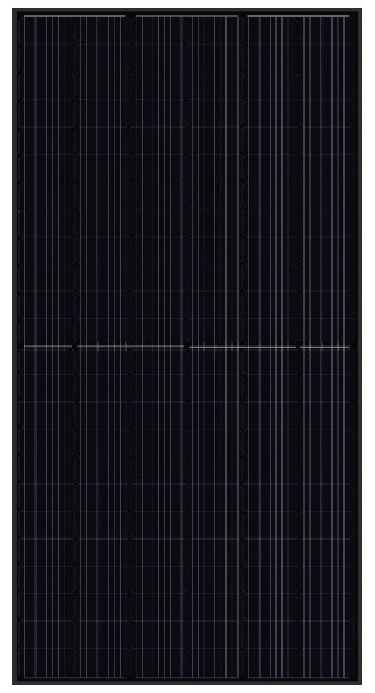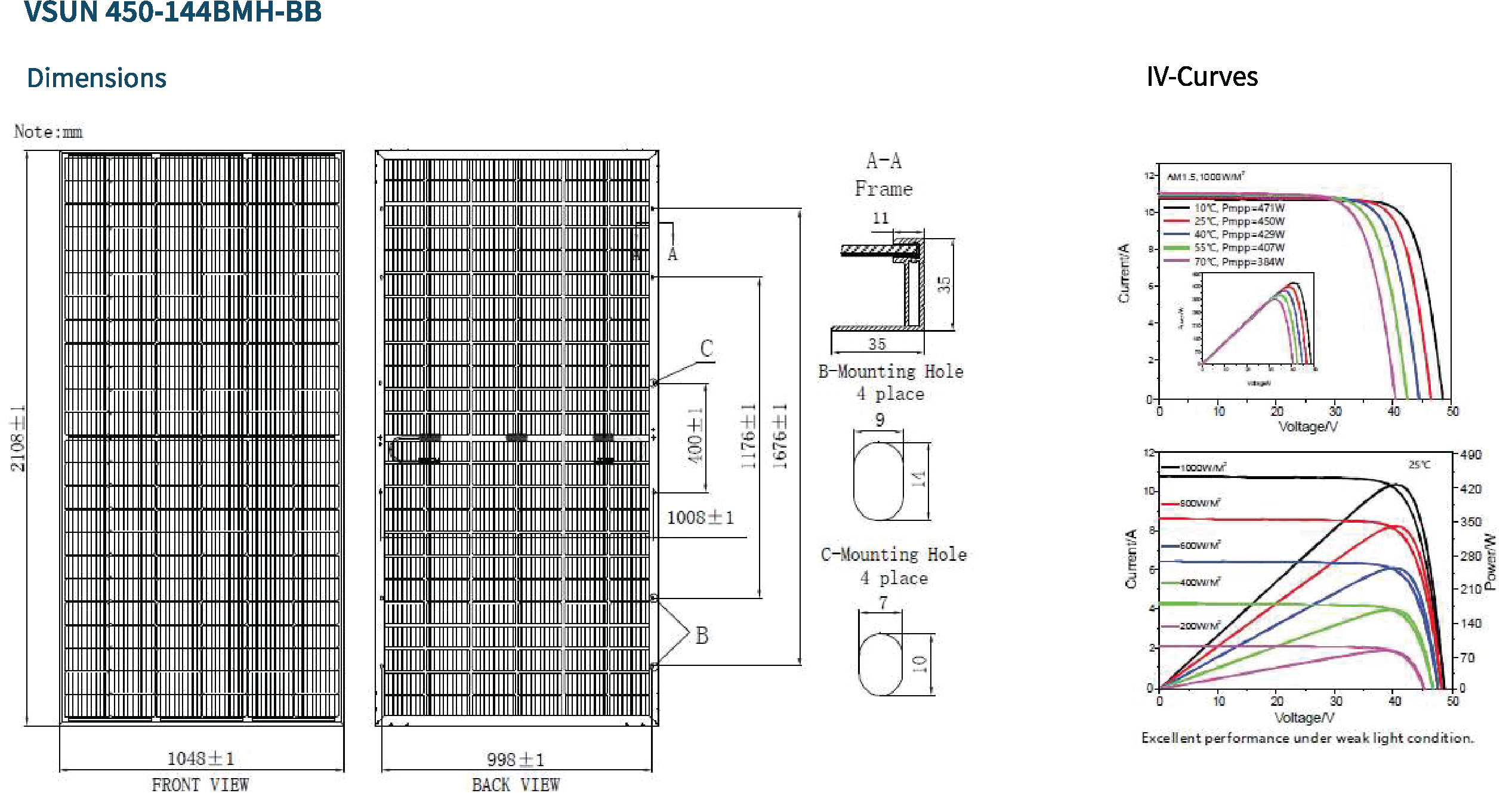Details of The Solar Panels
 |
Each industry-grade panel is designed with 35 years of technology expertise for a foundation for high-quality performance modules. The U.S. State Department, U.S. Military, and FAA all have these modules in their projects. Made in the USA from a sustainable, eco-conscious company. Features:
|
| PROFILE: | |
 |
 |
 |
|
 |
 |
 |
|
 |
|
 |
 |
| SAFETY PRECAUTIONS: Installation should be performed only by authorized personnel. All installations must comply with the applicable geographic electrical standards (i.e. International, National, Regional and local electrical standards, etc.). Within the modules there are no user serviceable parts. Do not attempt to repair any part of the modules. Do not use or install broken modules . In order to reduce the risk of electric shock, prior to installing the modules, remove metallic jewelry and use insulated tools during installation. Modules produce voltage even when not connected to an electrical circuit or load and have no on/off switch. Modules can be rendered inoperative only by removing them from sunlight, or by fully covering their front surface with cloth, cardboard, or other completely opaque non-marking material, or by working with them face down on a smooth, flat surface. Do not expose the modules to artificially concentrated sunlight. Do not stand on, drop, scratch, or allow objects to fall on the modules. Do not lift the modules by the junction box or junction box cables. Do not install or handle the modules when they are wet or during periods of high winds. Modules in packaging should not be kept outdoors exposed to rain. Ensure that junction box cables are provided with strain relief to avoid damage to the junction box, maintaining a minimum bending radius of 50 mm at all locations along the cable. Do not leave cable connectors exposed in adverse climatic conditions. Water and dust deposits inside the cable connectors can cause long term damage. A module with broken glass, torn or cut back sheet, damaged junction box, connectors or cables present electrical safety hazards and must be removed from service. The total voltage of modules connected in series corresponds to the sum of the voltages of the single modules; whereas connecting the modules in parallel results in adding up the currents. Consequently, strings of inter-connected modules can produce high voltages and high currents and constitute an increased risk of electric shock and may cause injury or death. For installation, maintenance, or before making any electrical connection or disconnection, ensure all modules in the PV array are exposed to a light intensity that is less than 400W/m2 as measured by an accurate solar meter/pyranometer. Methods to reduce solar radiance when making electrical connections or disconnections include: Covering the modules with an opaque cloth or other material in order to shield them from exposure. Making the connections during hours of low intensity of solar radiance (such as early morning or late afternoon.) |
|
| MAINTENANCE: It is recommended to regularly clean the modules to ensure maximum power output. Module cleaning should be done in the early morning, in the evening, at night or on rainy days when solar radiance is low. |
 |
| Steps of Cleaning: 1.Whisking: Debris such as dust and leaves on module surface should be removed with dry cloth. 2.Scraping: Hard foreign matters such as dirt, bird droppings, plant branches, etc., should be scraped off with non-woven fabric or hair brush. 3.Washing: Colored substances, such as bird dropping, plant juices, etc., on module surface can be removed by cleaning by spraying water onto the dirty region and scraping with hair brush or non-woven fabric. The pressure of the cleaning water should be less than 690Kpa (100 PSI). 4.Cleaning of snow: The modules can withstand heavy snow pressure up to 5400 Pascal. Do not try to remove frozen snow or ice from the module. Use a hair brush to gently remove the snow. |
|
| DIAGNOSIS AND TROUBLESHOOTING: The strict quality controls in the manufacturing facility ensures all of our modules are sold free of significant defects, breakages and/or other problems. However, in its operation some problems may arise that can alter the correct operation of the modules. In the event of accelerated deterioration of the module, contact HCI Energy immediately to make the necessary replacement. |
MODULE IDENTIFICATION: Moreover, each module has a specific label that is attached on the rear side. This label specifies the product information including type, power and electrical parameters. Product label has a QR-CODE to download more information. |
| HANDLING OF MODULES: Cells may be subject to damage if the modules are improperly handled or installed. Wear protective gloves when handling and installing the modules to protect against cuts and burns. Handle the module in a way that avoids breakage or scratching of the glass or back sheet and mechanical damage to any other part of the module. Do not carry the module by its cables. Electric shock or damage to the module may result. Do not drop sharp or heavy objects on either surfaces of the module. Do not subject the modules to any impact, and do not flex them mechanically. In the event of any damage to either the front or the back of the module, dangerous electrical hazards may exist, especially if the module is connected in series to a string. Replace the module immediately and take extreme caution when handling. Do not step or stand on the PV Module. |
|
| INSTALLATION: Overview The fire rating of the modules is valid only when mounted in the manner specified in the mechanical mounting instructions. When installing solar modules, local building code requirements and regulations must be adhered to at all times. In case of roof mounting, the appropriate system fire class rating of PV module with mounting system in combination with roof covering and slope applications should be considered. Solar modules are fire rating Type 1 or Type 2 in accordance with UL 1703 standard. Sufficient ventilation of the module backside is required to maintain the Type 1 or 2 fire rating, and therefore the mounting configuration (e.g. sufficient clearance) should be adapted accordingly. The recommended clearance distance is a minimum 3- 5/16” (10 cm). To maximize the rate of energy conversion, modules have to be installed in the best orientation and tilt according to your region. To prevent solar module hot spots and/or reduction in power, find a location that has the lowest shading. Avoid low tilt angles to prevent the accumulation of dirt/debris along the module edge. Modules must be spaced a minimum 3/8” (10 mm) a part on all sides to provide space for thermal expansion and to provide ventilation. Do not drill any additional holes into the module frames and do not cover the drainage holes. Do not mount modules in a position where the junction boxes are upside down (leads facing upwards). |
|
| Mounting Method Using Mounting Holes: Each module must be securely fastened at a minimum of four (4) points. Only use the 4 pre-drilled mounting holes on the PV module frame to bolt the module with 1/4” (M6) stainless steel screws and nuts to the mounting framework. The distance of the mounting holes has been designed in order to result in a uniform wind and snow load without damaging the module. |
 |
 |
|
|
Mounting Method Using Clamps: |
|
| ELECTRICAL CONNECTION: Do not connect or disconnect modules under load! Danger! Risk of serious injury or death from electric shock or electric arc flash! Only connect modules with the same rated current in series and modules with the same rated voltage in parallel. High hazardous voltage (several hundreds of volts) may occur during installation. Consequently, installation and maintenance of the modules, as well as the connection to the main power supply, may only be performed by authorized and qualified persons. Under normal conditions, a PV module is likely to experience conditions that produce more current and/or voltage than reported at standard test conditions. Accordingly, the values of Isc and Voc marked on the module should be multiplied by an appropriate safety factor to be determined by the design engineer based on local electrical code requirements. As a worst case, use a safety factor of 1.25 for voltage and cable amperage and a safety factor of 1.56 for fuse sizing. The maximum system voltage rating is 1000V for TUV/IEC and 1000V for UL. The maximum series fuse rating is 20A. The bypass diodes are not over-current protection devices. In the event of known or suspected diode failure, installers or maintenance providers are needed to change diode or panel. To obtain the desired system voltage, modules are wired in series connection. The recommended maximum series configuration must NOT exceed the certified maximum system voltage stated in the module spec sheets calculated in the worst case Voc conditions to be determined by the engineer of record (EOR). Refer to the appropriate local geographic electrical codes and regulations for the correct Voc correction factor according to the respective temperatures. If this information is not available, a 1.25 multiplying factor can be used as default value for correction of Voc. For connection of the modules use only appropriate cables with a minimum conduct cross-section of 4 mm2 that is compliant to the relevant jurisdiction code. Verify the junction box lid is firmly closed before installing the module. Do not repair or reconnect junction box cable. It may occur spark or electric shock. Do not bend junction box cable. Under stress, it can damage the module. Cable bending radius should be at least more than 4 times the cable diameter. Before connection of the system to the grid, the PV system must be approved for correct installation, by all appropriate authorities. Lightning protection is recommended for PV systems that are to be installed in locations with high probability of lightning strikes. The design of the PV system should be done by a qualified person familiar with PV system design. HCI Energy does not assume any responsibility for how the modules are installed or how the system is designed. For all solar systems, the connectors MUST be UL rated for interminability and fully inter-matable with the solar modules’ connectors. Otherwise, HCI Energy will void the warranty and will not be responsible for any resulting safety issue. Solar modules are equipped with factory-assembled Junction box with 12AWG/4mm2 cables, and insulated for 90°C maximum, with either GZX PV-GZX0601-1-F, PV-GZX0601-1-M or MC4 connectors. Any attempt to repair/modify the junction box, cable, or connector will void the warranty. |
|
| PROTECTIVE GROUNDING: In order to prevent electrical shock or fire, the frame of the module as well as any non-current carrying metal parts of the system must be electrically grounded. While this section provides some information about grounding the solar frames and modules, reference should be made to local statutes and regulations for specific requirements on grounding. As an additional resource, reference the U.S. National Electrical Code addresses equipment grounding/bonding requirements in Article 250. You may also reference Canadian Electrical Code requirements located in CSA C22.1. Proper grounding is achieved by bonding all exposed non-current carrying conductive parts to the appropriately sized equipment grounding conductor (EGC) or racking/rail system that has been tested and verified to be used as a means of integrated grounding. The frames are protected from corrosion via an anodized coating. This coating must be penetrated in order to ensure proper bonding for equipment grounding requirements. The different methods outlined below are suggested methods to establish an appropriate bond between the frame and the EGC or racking system. The installer must ensure that the ground path of the EGC or racking system follows proper grounding requirements. Both Option A and Option B must be grounded as per NEC Article 250 or CSA C22.1, whichever may apply to your local jurisdictional and code requirements. |
|
| Option A: Use of a Grounding Lug A UL listed grounding lug can be bonded to the grounding hole located on the bottom flange of solar module frame. The holes are marked with an electrical ground symbol: |
 |
| To install the grounding lug, follow the specified instructions of the manufacturer. The grounding lug should be made of stainless steel or tin plated metals such as aluminum to avoid corrosion. The grounding lug should be attached to the frame grounding hole using stainless steel hardware (screw, toothed lock washer or KEPS nut). A lock washer or other locking mechanism is required to maintain tension between the bolt and assembly; HCI Energy recommends a torque value of 25 inch-lbs. The conductor must be attached to the ground lug using the lug’s set screw. Refer to NEC Article 690. Care should be taken to avoid the use of grounding hardware of dissimilar metals which may lead to corrosion. Ensure that the grounding area for the connection is clean and free from oxides and/or any debris that could impede the pathway for the electrical ground. Always follow safety procedures when installing any grounding/ mounting system. | |
| Option B: Integrated Grounding Methods: A solar module can be bonded with a racking/rail system using a UL1703 or UL2703 certified integrated grounding method. The racking/rail system will then have to be electrically grounded in such a way that the overall system is properly grounded per local requirements and regulations such as what is defined in NEC article 250 or Canadian CSA C22.1 and regulations such as what is defined in NEC article 250 or Canadian CSA C22.1. One example of an integrated grounding method is the use of a washer recognized as meeting UL2703 requirements between the module and the racking/rail system, and is listed on UL’s product database. An example of a UL2703 recognized integrated grounding method is a WEEB washer which HCI Energy has found to be generally compatible with the modules, however each combination of module/racking system requires a specific WEEB washer size. It is the responsibility of the installer to ensure that the specific size requirement has been met and is used appropriately per the manufacturer’s installation manual. Note, WEEB washers are intended for single-use only; they must not be reused after removal or loosening. Refer to Wiley’s installation instructions for the specific use of WEEB washers. Other grounding methods may be used in conjunction with a module mounting system tested to UL2703. For these installations, the solar module and frame style must be tested and part of the instructions for the listed mounting product. The solar module must be installed in accordance with these instructions as well as the mounting system’s listed instructions. |
|

